Pygmy goats part 2: housing and other facilities
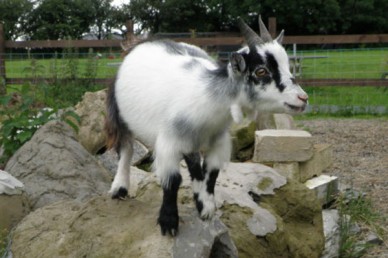
Having broadly considered the various issues surrounding your initial purchase of pygmy goats in the previous article, we now look at the specific facilities needed to provide a comfortable environment for them.
Few of us will have the luxury of moving into premises with the ideal outbuildings and land at hand: adaptation and compromise are usually the name of the game. Be sure that whatever is available can be satisfactorily adapted to fulfill certain criteria: whether thinking of buying just a few pets or foundation breeding stock, the area and buildings have to be suitable for their needs.
If you only intend to keep two or three pet goats at a time then a main shelter of about 8ft x 10ft (such as a sturdy garden shed) will be perfectly adequate. This will leave room for the erection of a bench or two and a sufficient area for them to move around should the weather be bad. If more space is available, then all well and good. Bear in mind that should your stock come from different sources then they may need to be separated at night, at least initially until they get used to each other. This can be readily achieved by the use of hurdles.
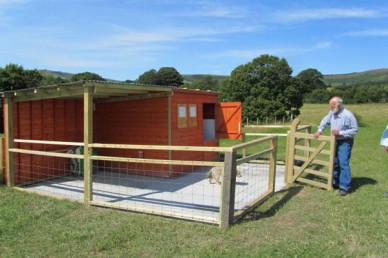
An ideal arrangement for 2/3 pygmy goats, including outdoor covered area with indoor accommodation
If you intend to buy breeding stock, then the facilities required need to be more carefully considered. Bearing in mind that pygmy goats will give birth to twins at least 60% of the time, small herds can very soon become large herds and have to be appropriately accommodated. Remember also that the optimum herd size depends on the land available. Six pygmy goats per acre is about right with overstocking a recipe for disaster both in terms of health and land management.
Housing
Housing for goats varies considerably. You would be very lucky to inherit a ready made goat house and even then, it may not be exactly to your liking. Remember optimum herd size. With this in mind, it may be better to have a larger building that can be adapted to accommodate a sizeable herd than to end up having to add piece meal to a smaller construction in the future.
What materials to use when erecting or converting a building again can vary. It would be wise to try and find out how other keepers house their stock, to consult magazines and to cost out alternatives.
If a large outbuilding is available, then think carefully about how to divide it. Hurdles are excellent for this, especially if you wish to try out different options initially. It may well be worth trying out a variety of pen sizes for a family of goats or for individuals. Relationships change between groups, just as they do in human families. Twin kids with mum in one area may be fine for a while, but when mum kids again, the now goatlings will be given the heave-ho in no uncertain terms, much to their bewilderment. Pecking order can change: an affable individual may become a grumpy old bully when she gets older.
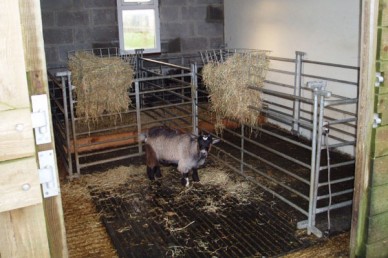
Hurdles provide flexibility of accommodation
Whereas flexibility of accommodation can be easier with hurdles , more permanent divisions with wooden partitions and of course doors can be equally useful, especially if there are a couple of spare pens erected to accommodate relationship change if necessary.
Ventilation
Ventilation in buildings should be a prime consideration however many goats you keep. A stable door type arrangement with a top that can be partially closed using a cabin hook when necessary would be my recommendation. Cross-ventilation is important and, to this end, there should be small window/s at the back of the building capable of being opened to provide adequate air flow. These windows should be perspex, never glass, to avoid inevitable breakages when they jump up to look out. Never close everything up completely, especially on smaller buildings. It is also important not to site buildings so that they are directly exposed to northerly winds.
Flooring
Flooring is a major consideration. Many favour earthen floors that allow for natural drainage, but concrete flooring is more hygienic as it can be washed down and disinfected. Lightweight rubber cow matting, usually sold in 6ft x 4ft units placed over the concrete, provides additional warmth and comfort. These mats are easily handled and removed outside where, once washed over, they dry quickly. The number of mats required could be built up gradually as finances allow. Start by putting some down under the bedding area and work out from there. Rubber mats are quite good to use over wooden shed floors which, if not covered, tend to smell and rot away.
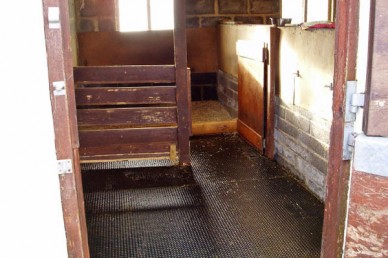
Lightweight cow matting provides extra warmth and comfort
Bedding
Straw is the most commonly used bedding, probably because it is the cheapest. It certainly looks very inviting when first put down, but has to be laid fairly deeply if it is to provide sufficient warmth for the animals, especially during the winter months. It is not particularly absorbent and can become somewhat smelly if not frequently changed, or if the wet spots are not removed and replaced daily. It is very often used as a deep litter system.
Wood shavings can be used used either as a stand alone alternative or a lining for straw. Shavings are certainly more absorbent than straw but need to be topped up fairly frequently as they bed down quite quickly. If used during kidding, a layer of straw over them is required, otherwise ‘breaded kids’ will be the order of the day.
Aubiose, a hemp based bedding material, is more absorbent than either straw or shavings. It is more expensive but is good for animals that suffer respiratory ailments and once the initial bed has been laid is quite easy to maintain.
Flax is my bedding of choice. It is eight times more absorbent than straw and four times that of shavings. In addition, it makes excellent mulch for the garden. It is priced at about the same as wood shavings, but lasts very much longer. About 4/5inches is the recommended starting depth for a new bed, with wet patches again being removed and replaced. The ‘breaded kid syndrome’ still applies!
Bedding can be retained with the use of box-like wooden frames or wooden planks held in place by small vertical wooden retaining blocks attached to the walls. Alternatively, a line of breeze blocks would suffice.
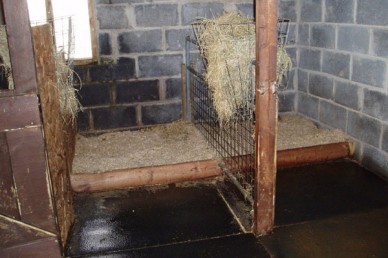
Bedding can be retained behind wooden planks.
Hayracks and water buckets
Hayracks should always have lids. Many a kid has been known to jump up into the rack and to break a leg on jumping out, so do not take the risk. They need to be placed so that young stock can have access to the bottom of them but at a comfortable height for the adults. Moveable racks can be placed outside on dry days and are most useful in this regard. They are also good for moving around if hurdles are used for separation of stock. Hayracks with small mesh will cut down on hay wastage.
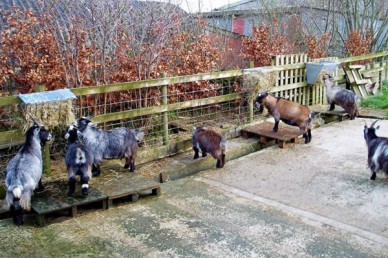
Moveable racks can be placed outside on dry days
Water buckets are best placed in a support ring, well off the ground especially when kids are very young. Water for the kids to drink should be placed in small bowls.
Fencing
Whatever land is available, the periphery has to be properly fenced. This is of the utmost importance. No barbed wire should be included anywhere. Stock fencing is most commonly adopted, together with post and rail. The wire should be properly tightened with no gaps left at ground level. Loose fencing will very soon be lifted and crawled under, especially by kids. It should include a wooden rail above the stock wire. The disadvantage of this type of fencing is that young horned stock, especially, can occasionally get their horns caught. Chain link fencing is another option but is expensive. Strong, weld mesh fencing together with post and rail is probably the best option overall. What ever is decided upon, it has to be tight with no gaps at ground level.
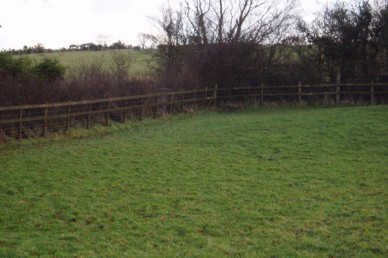
Good fencing is of the utmost importance
Pasture
If only 2 or 3 goats are to be kept in a limited space, then it is best to have the whole area laid down to hard standing, as a small area of grass will soon become worm burdened.
The amount of pasture required is a constantly asked question. The more there is available the better, within reason. Areas of about an acre for six or so animals, which could be rotated with an area of a similar size annually, would be ideal. A third rotatory area would be a luxury indeed but if you have the space you should use it as paddock rotation is the only way of keeping down the worm burden. Ideal scenarios are unfortunately few and far between and worming issues will be considered in a later article.
Pasture should be well drained and the grass kept to a reasonable length, say no longer than six inches (15cms) maximum. Goats turned out on wet grass, especially without a rumen full of hay, can readily suffer from bloat. Try and ensure that your goats have been inside long enough with a sufficient hay supply before releasing them. Paddocks benefit from harrowing in early spring to remove dead growth.
Hard standing
The vast majority of goat housing does not have sufficient hard standing surrounding it. If anything is neglected by goat keepers, it is this. The outside of buildings, where stock is constantly moving in and out, will get mudded up in no time. Goats need space to play and move outside of their sleeping areas, especially in the winter when the weather is so unpredictable. Benches can be erected outside and moveable hayracks are a great asset. Not providing an adequate amount of hard standing can also have a detrimental effect on the feet of the goat, encouraging foot rot and the like.
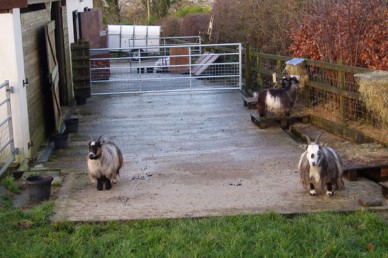
Housing should have sufficient hard standing outside
Field Shelters
If pasture is not adjacent to the goats’ permanent accommodation, then a field shelter needs to be provided. A goat’s coat, unlike that of sheep, is not waterproof and does not contain lanolin. In any case, goats hate the rain and will readily seek shelter at the slightest drop of moisture. It will need to be an appropriate size for the number of goats and it would also be wise to consider including multiple entrances, as some goats are quite bossy and may try to prevent members lower down in the pecking order from entering.
Play Area
Even older goats love to have play areas on which to lie down, jump about and run along. There can never be too much provided. They tend to develop the tendency to escape only if they are bored, if they are constantly bullied or if fencing is inadequate. Play facilities need not be elaborate: a couple of solid faced pallets placed and secured together with planks inclined against them would amuse them for hours. Some goat keepers construct the most imaginative arrangements. Whatever is created should be safe and secure.
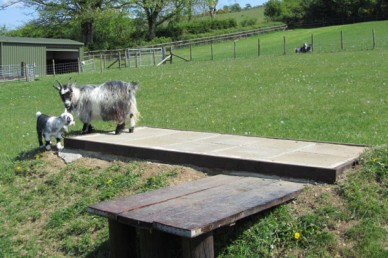
This and the lead image show different types of play area
Part 3 in the series examines the routine tasks required to keep your goats in tip-top condition
Part 1 – Before buying your goats
Part 2 – Providing the appropriate environment
Part 3 – Routine tasks
Part 4(a) – Nutrition – the ruminant stomach
Part 4(b) – Nutrition – feeding according to need
Part 5 – Health
Part 6 – Introduction to breeding
Part 7 – Attending shows
15 Comments
Leave a reply
Livestock categories
Most recent Livestock articles
- How to Maintain Your Paddock 09th September, 2017
- Absolute beginner’s guide to breeding sheep 05th November, 2016
- Absolute beginner’s guide to keeping sheep 02nd October, 2016
- Beginning back garden beekeeping 06th September, 2016
- Mini Moos: The world’s most popular beef cattle ‘repackaged’ for smallholders 24th August, 2015
- Iron Age Pigs: this boar is no bore 04th August, 2015







Hi have a male and female pigmy goats who are now 10onths old my male goat has put on weight due to him being a little greedy once he eats his breakfast of cereal he pushes my female goat out of the way and eats hers any suggestions on what to do
thanks grace
Hi I’m thinking of buying 2 Pygma goats in the new year for my son. Have you any other pen designs available. Thanks
Unfortunately we don’t have specific designs available but pens can be created by fencing any suitable piece of land. As long as you have enough area, a shelter that fulfills their requirements and understand the the responsibility of taking on livestock you have a good starting point. Perhaps look for a local beginners course before deciding.
what’s the minimum space for 2
I live in south portugal, it’s mild at night. I’m about to go away for 2 nights, there at be rain showers. They have shelter under a tree. As this is a temporary grazing area for them. Will they be ok with no house for this short amount of time? Thanks in advance 🙂
Pygmy goats don’t like being wet so if you can provide some shelter from the rain that would be ideal.
#PocketFarm What is the minimum amount of space needed for two male Pygmy goats?
Hi. You wouldn’t usually keep two entire males together in the same enclosure. If the are castrated they will live together quite happily in a fairly modest space, say quarter of an acre, although half an acre would allow more room for rotation of the land.
Thanks Pocketfarm if I need any more advise I will contact y’all.
Hi – how / where do you dispose of the old shavings used for the bedding?
thanks
Shavings are completely diodegradable so they can be composted or if there is not too much of it disposed of at a council recycling point in the garden waste bins. What do other keepers do with theirs, be interested to hear your solutions?
We have for sheep some bantam hens and A small pony Who all seem to get on very well or Pygmy goat’s social?
Pygmy goats can get on well in a mixed farmyard environment but as always its best to introduce carefully (perhaps pen them near the other animals initially) to see if there are any disagreements first.
Hello, we are getting 2 baby male pygmy goats that have both been castrated and had their horns removed. We also have 2 cats, will the cats go for the goats?
Cats should prove a problem with goats